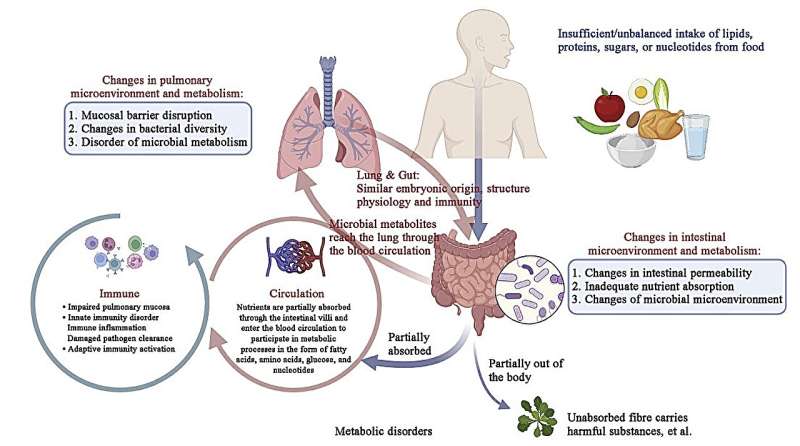This article has been reviewed according to Science X's editorial process and policies. Editors have highlighted the following attributes while ensuring the content's credibility:
fact-checked
proofread
Study uses metabolomics to identify novel diagnostic markers for chronic obstructive pulmonary disease

Chronic obstructive pulmonary disease (COPD) is a chronic lung disease with irreversible airflow limitation and a leading cause of death worldwide. COPD is characterized by chronic bronchitis and emphysema and is associated with malnutrition, muscle weakness, and an increased risk of infection.
Although pulmonary tests are considered as the gold standard for COPD diagnosis, they cannot detect early stages of COPD, leading to underdiagnosis. This emphasizes the need for specific biomarkers for early diagnosis, classification, and clinical interventions.
Recent studies suggested that changes in lipids, amino acids, glucose, nucleotides, and microbial metabolites in lungs and intestine can effectively diagnose early COPD. Metabolomics, a discipline that analyzes different metabolites from body fluids, has emerged as a prominent technique for COPD assessment. However, there are no studies that identify and summarize the metabolites that significantly change during COPD.
A recent review by Dr. Wenqian Wu, Dr. Zhiwei Li, Dr. Tiantian Zhang, and Dr. Hongmei Zhao from the Peking Union Medical College, along with Dr. Yongqiang Wang from 302 Hospital of China Guizhou Aviation Industry Group, and Dr. Chuan Huang at the Chinese Academy of Medical Sciences, provided an in-depth account of the advances in metabolomics of COPD over the last five years, highlighting some potential diagnostic markers and therapeutic targets.
Their study was published in Chinese Medical Journal Pulmonary and Critical Care Medicine.
Sharing the motivation behind their study, Dr. Tiantian Zhang and Dr. Hongmei Zhao explain, "In addition to altered metabolites from body fluids, increasing evidence has shown that metabolites from pulmonary and intestinal microbes could help us understand the pathogenesis of COPD and the complex regulation underlying this disease."
Many studies have reported that the three major nutrients, namely protein, lipids, and glucose, along with nucleotide metabolites, are closely associated with COPD development and progression.
They found that levels of lipids like sphingolipids and their metabolites, cholesterol, and high-density lipoprotein (HDL), are significantly changed in individuals with COPD. This leads to oxidative stress, inflammation, lipotoxicity, and thus impaired lung function. Various studies suggested that reversing abnormal lipid metabolism and administration of beneficial lipids might alleviate COPD effects and cardiopulmonary comorbidities.
Dysregulation of amino acid metabolism leads to the accumulation of harmful metabolites, such as desmosine, isodesmosine, and elastin peptide, which aggravate the damage to the lungs. Furthermore, COPD patients have abnormal levels of amino acids and reduced synthesis capacity of antioxidant carnosine. Some studies suggested that supplementation with amino acids and N-acetylcysteine might be able to regulate amino acid metabolism in COPD.
Glucose metabolism is crucial for energy generation and triggering the immune system. However, this metabolism is dysfunctional in COPD patients, resulting in chronic fatigue, muscle weakness, and an impaired immune response to pathogens. Further investigation revealed that COPD patients have impaired nucleotide metabolism, leading to abnormal levels of adenosine triphosphate (ATP), cyclic adenosine monophosphate (cAMP), and cyclic guanosine monophosphate (cGMP).
Nucleotide metabolism impacts metabolic processes, and further studies are warranted to investigate the correlation between nucleotide metabolism and the metabolism of lipids, amino acids, and glucose.
Besides metabolic disorders, microorganisms and their metabolites also play a key role in COPD pathogenesis. Individuals with COPD are prone to microbial colonization in their lower respiratory tract. The authors found that both pulmonary and intestinal microbes and their metabolites invade and impact the lungs.
Different studies have identified certain common bacteria associated with lung disorders—Streptococcus, Haemophilus influenzae (H. influenzae), Pseudomonas aeruginosa, Campylobacter, to name a few. H. influenzae forms a biofilm in the lower airways that acts as a bacterial depot, leading to recurrent infections, microbial resistance, and evasion of the host immune system.
Although current studies mainly focus on the bacterial microbiome, fungi, and viruses are equally important and demand further studies.
Interestingly, chronic lung disorders like COPD impair the gut membrane, increasing gut permeability, microbial movement, and endotoxin release, resulting in gut dysbiosis (disease-induced imbalance in microbial populations) and a weakened immune response.
The intestinal microbiome of COPD patients consists predominantly of microorganisms that reduce lung function, further establishing the correlation between gut microbiome and COPD. On the other hand, gut microorganisms and their metabolites, like short-chain fatty acids, might play a crucial role in alleviating COPD. Thus, gut microflora might be a potential marker for early diagnosis and treatment of COPD.
Overall, this study suggested that efficient regulation of lipid, amino acid, glucose, and nucleotide metabolism, along with pulmonary and gut microbial metabolism, is essential for COPD management. Dietary modifications to a low-carbohydrate diet and increasing fiber, antioxidant, and vitamin uptake help in COPD prevention.
Dr. Zhang and Dr. Zhao conclude by saying, "Dietary regulation prevents or suppresses respiratory infections by regulating the intestinal microenvironment, which is surprisingly effective in alleviating the symptoms of COPD. We emphasize that intensified dietary management may be among the most feasible methods to improve metabolism in the body."
More information: Wenqian Wu et al, Advances in metabolomics of chronic obstructive pulmonary disease, Chinese Medical Journal Pulmonary and Critical Care Medicine (2023). DOI: 10.1016/j.pccm.2023.10.001




















